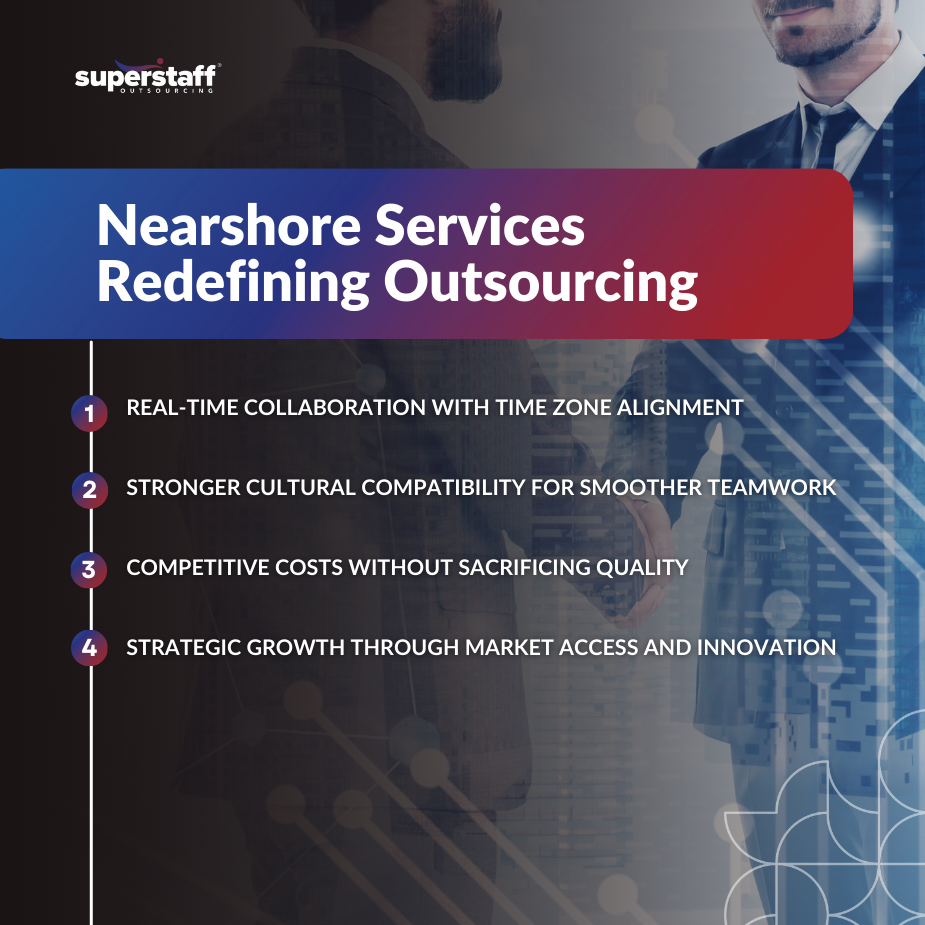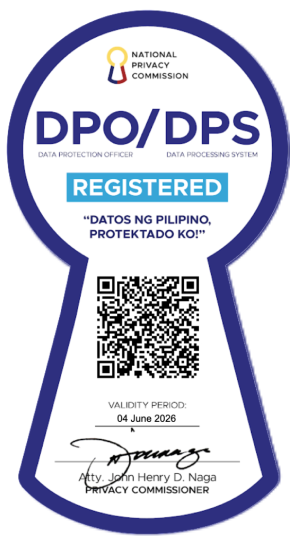
For years, outsourcing was synonymous with chasing cost savings across oceans. Yet business leaders today are redefining priorities. More than just cutting expenses, executives now value proximity, cultural alignment, and the ability to respond to market changes in real time. This is where nearshore services come in, reshaping what outsourcing means in a global economy that prizes speed and agility.
Traditional offshore models certainly delivered savings, but the challenges often outweighed the benefits. Companies found themselves juggling time zone gaps, cultural disconnects, and slower collaboration cycles that affected agility. Nearshore outsourcing is rewriting that script, giving executives a way to maintain efficiencies while gaining closer, faster, and better partnerships. This blog explores why this shift matters, and how decision-makers can position their organizations for success through nearshore strategies.
From Offshore to Nearshore: A Strategic Shift
When outsourcing first entered the mainstream, it was celebrated as a breakthrough for reducing operational expenses. Companies were eager to tap offshore locations for labor arbitrage. Yet as global industries matured, the limits of this approach became clear. Communication delays stretched projects longer than anticipated. Customer-facing services sometimes missed the mark due to cultural divides. For leaders managing operations across continents, the very benefits of outsourcing came with steep trade-offs.

This is why the pivot toward nearshore outsourcing is so significant. Nearshore partnerships are not built solely on savings but on strategic alignment. Businesses now prioritize operational speed, cultural compatibility, and seamless collaboration. These qualities are harder to achieve in a purely offshore environment. For instance, a U.S. company partnering with a team in Latin America can engage in near-real-time conversations without waiting until the next business day.
Nearshore services answer the long-standing frustrations of offshore outsourcing by enabling faster decision-making and shortening the gap between strategy and execution. This strategic shift highlights how proximity is becoming just as valuable as price.
Time Zone Alignment Drives Real-Time Agility
In business, timing often determines success. A single delay in communication can mean missed opportunities, delayed product launches, or slower responses to customers. Offshore arrangements often placed companies in situations where a full day passed before they received critical updates. That lag may have once been acceptable when the focus was strictly on cost, but in today’s fast-paced markets, agility cannot wait.
With nearshore services, companies gain the benefit of overlapping work hours. North American businesses can align seamlessly with partners in Latin America, where working schedules mirror U.S. business hours. This means leaders can collaborate with their teams in real time, approve decisions quickly, and address customer concerns without overnight gaps.
The ripple effect of this alignment is transformative. Project managers can hold agile sprints without delay. Customer support can resolve issues on the spot. Back-office processes flow more smoothly because all parties are synchronized. These are not theoretical advantages—they are everyday realities for companies that adopt nearshore outsourcing models.
When time zones align, responsiveness becomes a competitive edge. This allows leaders to focus less on chasing updates and more on driving growth. And while time zone proximity is a powerful driver, cultural compatibility amplifies these benefits even further.
Cultural Compatibility Enhances Collaboration
Outsourcing is not simply about transferring tasks; it is about building trust and relationships. For many executives, offshore outsourcing sometimes fell short in this area. Different cultural norms, communication styles, or even holidays could create friction in workflows and client interactions.
Nearshore teams bring a level of cultural familiarity that significantly reduces these barriers. Shared values around work ethics and customer service expectations make collaboration smoother. Many nearshore hubs also share linguistic strengths, particularly in bilingual Spanish-English capabilities, which strengthen customer-facing roles for global companies expanding in North America and beyond.
Consider the experience of a U.S. company working with a customer service team in Colombia. Both teams celebrate similar holidays, work within aligned business rhythms, and share a common understanding of customer expectations. This creates stronger relationships not just within the business partnership but also in how brands are represented to end customers.
When cultural compatibility meets real-time collaboration, organizations experience smoother workflows and improved results. This balance is why nearshore services are increasingly attractive for leaders who want outsourcing to be an extension of their corporate culture, not just an external resource.
Balancing Cost Savings and Quality
While cultural and time zone benefits are undeniable, decision-makers still keep a close eye on budgets. What makes nearshore outsourcing particularly compelling is that it delivers both quality and cost effectiveness. Leaders no longer have to choose between saving money and maintaining service excellence.
The typical costs of nearshore outsourcing are significantly lower than domestic hiring in the United States, yet without the steep drop-offs in quality sometimes associated with offshore models. Companies can access skilled professionals across customer experience, IT, and back-office roles while maintaining competitive pricing. Attrition rates also tend to be lower in nearshore hubs, reducing the hidden costs of constant retraining and turnover.
By choosing nearshore outsourcing, organizations strike a balance between efficiency and value. They can scale operations quickly, add specialized talent when needed, and maintain customer satisfaction without shouldering the full weight of U.S.-based labor costs. For executives tasked with driving performance while managing expenses, this is a strategic equation that works in their favor.
Ultimately, the appeal lies in achieving both outcomes. Businesses can secure cost savings while ensuring the brand experience remains consistent and high quality. That balance is not always achievable with traditional offshore approaches, which is why nearshore services stand apart.
Nearshore as a Catalyst for Business Growth
Perhaps the most compelling argument for adopting nearshore models is their role as growth accelerators. Cost savings and efficiency are important, but true value comes when outsourcing strategies directly contribute to market expansion and innovation. Nearshore services have become a key enabler of both.
By engaging nearshore partners, companies open doors to new markets, particularly in Latin America. Access to bilingual professionals helps brands connect with both English and Spanish-speaking customer bases. This is especially valuable for companies targeting the U.S. Hispanic population or looking to expand into regional markets.
Beyond market access, nearshore services support digital transformation initiatives. Businesses undergoing modernization in areas like cloud migration, data analytics, or customer experience technology benefit from the agility of teams operating in closer collaboration. The speed of execution becomes a competitive advantage in industries where responsiveness defines leadership.
Executives considering global strategies are also weighing the advantages of choosing nearshore outsourcing companies. These advantages include agility, cultural alignment, and the ability to scale quickly without losing control of operations. Together, they position nearshore as not just a cost-saving mechanism but as a foundation for competitive growth in demanding markets.
Nearshore Services as the Future of Outsourcing
The story of outsourcing has evolved from distant cost-saving models to partnerships built on speed, collaboration, and cultural alignment. Nearshore services embody this evolution, offering companies a closer, faster, and better way to extend their capabilities globally. By aligning time zones, strengthening cultural compatibility, delivering balanced costs, and enabling growth, nearshore outsourcing redefines what business leaders can expect from global partnerships.
For SMEs and midmarket companies, the opportunity lies in acting now. Waiting means continuing to struggle with time zone delays, cultural gaps, and less agile offshore operations. Choosing nearshore services ensures your business stays responsive and competitive in a world where timing and alignment make all the difference.
At SuperStaff, we help businesses like yours tap into the proven advantages of nearshore services with tailored strategies that deliver speed and quality. Our teams are trained to operate as true partners, working side by side with you to drive success. Connect with SuperStaff today and discover how nearshore services can transform your outsourcing experience into a growth engine for your business.






